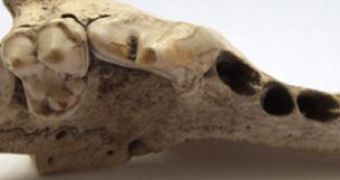Archaeologists found in a Swiss cave, a jaw fragment belonging to an ancient dog. After radiocarbon-dating it they concluded that it is over 14,000 years old and that it might be the earliest dog ever known.
Establishing when the first fully-domesticated wolf became a dog is a rather sensitive subject among researchers, and some already say that fossils much older than the Swiss have already been discovered. Scientists have different theories about how and when dogs originated, as one analysis of modern dogs and wolves concluded that the first domesticated wolf (the first dog) lived in Asia, another in Eastern Europe and a third in the Middle East.
Well, archeology graduate student Hannes Napierala and archaeologist-zoologist Hans-Peter Uerpmann, study coauthors at the University of Tübingen in Germany say that the upper-jaw discovered in 1873 in Kesslerloch Cave, near Switzerland’s northern border with Germany, proves that domestic dogs lived there betwenn 14,100 and 14,600 years ago. Napierala states: “The Kesslerloch find clearly supports the idea that the dog was an established domestic animal at that time in central Europe.”
At Germany’s Bonn-Oberkassel site, scientists also found 14,000 year-old dog fossils among prehistoric people's tombs, according to Wired.
In a paper published online in the International Journal of Osteoarchaeology, the two researchers say that older fossil skulls identified by other teams as dogs are more likely to be Ice Age wolves. They also talked about a 31,700 year-old specimen discovered last century in Goyet Cave, Belgium, that was believed to be the world's oldest dog in 2009.
The leader of the analysis on the Goyet fossil, paleontologist Mietje Germonpré of the Royal Belgian Institute of Natural Sciences in Brussels, said: “the Kesslerloch dog is not the oldest evidence of dog domestication.”
Scientists say that the Kesslerloch jaw and the few teeth remaining on it are smaller that those of wolves recovered on the same site. They believe that domestication must have reached an advanced stage at the time of its death, because of a space between two teeth. At the beginning of the domestication stage, the jaws get smaller and teeth don't have enough space. Their crowded aspect disappears as they later shrink as well.
This debate is not yet closed and it will take much more research on additional fossils to establish dogs' history.

 14 DAY TRIAL //
14 DAY TRIAL //